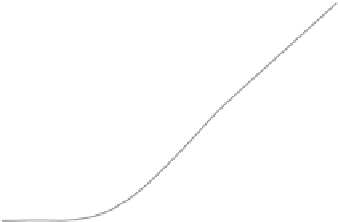Environmental Engineering Reference
In-Depth Information
140
120
Effect of concentration
24-h standard batch test
100
80
60
40
20
0
0
0.5
1
2
Log of P (concentration)
1.5
2.5
3
3.5
FIGURE 31.8
Effect of concentration on phosphorus removal capacity.
Phosphate batch test with 5052(2)—effect of pH
70
Capacity (mg/g)
65
60
55
50
45
40
35
30
6
6.5
7
7.5
8
8.5
9
pH
FIGURE 31.9
Effect of pH on capacities at 10 ppm of phosphorus.
Figure 31.8 shows that media capacity depends on the concentration of the phosphorus
in the bulk luid, as expected. Batch tests were conducted by mixing 100 mg of media with
100 mL of water. The desired concentration of phosphorus was added to the water, and the
pH was adjusted to 6.5. After tumbling in a plastic bottle for 24 h, the media was iltered
and the solution analyzed and capacity determined. Batch tests with silica and nitrate
(potential competing ions) had very little effect on capacity.
The pH of water is important in sorption of phosphorus, as shown in Figure 31.9. Removal
capacity is generally lowered at higher pH values (>7). Changes in capacity of one media at
a 10 mg/L phosphorus concentration were evaluated. Capacity decreased modestly (~12%)
as pH increased from 6.6 to 8.6.
31.4.3.1 Long-Term Testing with Actual Septic Tank Discharge
Long-term testing with actual septic tank discharge is being done using 5-cm-diameter
columns containing either granular or monolith media. Figure 31.10 shows phosphorus
consistently remains <1 mg/L at an empty bed contact time (EBCT) of 3 h.










